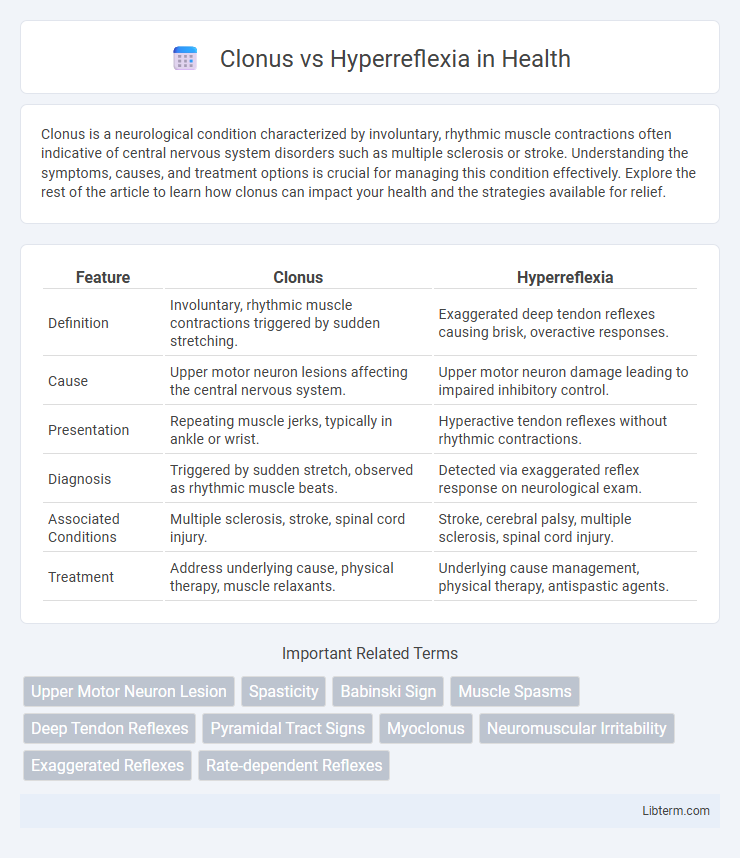Clonus is a neurological condition characterized by involuntary, rhythmic muscle contractions often indicative of central nervous system disorders such as multiple sclerosis or stroke. Understanding the symptoms, causes, and treatment options is crucial for managing this condition effectively. Explore the rest of the article to learn how clonus can impact your health and the strategies available for relief.
Table of Comparison
| Feature | Clonus | Hyperreflexia |
|---|---|---|
| Definition | Involuntary, rhythmic muscle contractions triggered by sudden stretching. | Exaggerated deep tendon reflexes causing brisk, overactive responses. |
| Cause | Upper motor neuron lesions affecting the central nervous system. | Upper motor neuron damage leading to impaired inhibitory control. |
| Presentation | Repeating muscle jerks, typically in ankle or wrist. | Hyperactive tendon reflexes without rhythmic contractions. |
| Diagnosis | Triggered by sudden stretch, observed as rhythmic muscle beats. | Detected via exaggerated reflex response on neurological exam. |
| Associated Conditions | Multiple sclerosis, stroke, spinal cord injury. | Stroke, cerebral palsy, multiple sclerosis, spinal cord injury. |
| Treatment | Address underlying cause, physical therapy, muscle relaxants. | Underlying cause management, physical therapy, antispastic agents. |
Understanding Clonus and Hyperreflexia
Clonus is characterized by a series of involuntary, rhythmic muscle contractions and relaxations typically triggered by sudden stretch, often indicating upper motor neuron lesions. Hyperreflexia refers to exaggerated reflex responses due to the loss of inhibitory control from the central nervous system, commonly seen in conditions affecting the corticospinal tract. Both clonus and hyperreflexia are key neurological signs used to assess disorders such as spinal cord injury, multiple sclerosis, and stroke, providing critical insights into motor neuron function.
Defining Clonus: Characteristics and Causes
Clonus is a neurological condition characterized by involuntary, rhythmic muscle contractions and relaxations, often triggered by sudden muscle stretching. It commonly occurs in patients with upper motor neuron lesions, such as those caused by stroke, multiple sclerosis, or spinal cord injury. These repetitive muscle spasms result from hyperactive reflex arcs due to disrupted inhibitory pathways in the central nervous system.
What Is Hyperreflexia? Key Features and Etiology
Hyperreflexia is an exaggerated reflex response resulting from an upper motor neuron lesion that disrupts the inhibitory signals to the spinal cord, leading to increased muscle tone and hyperactive deep tendon reflexes. Key features include brisk tendon reflexes, muscle spasms, and possible clonus, characterized by rhythmic muscle contractions in response to sudden muscle stretch. Etiological factors encompass spinal cord injury, multiple sclerosis, stroke, amyotrophic lateral sclerosis, and other central nervous system disorders affecting the corticospinal tract.
Clinical Presentation: Clonus vs Hyperreflexia
Clonus presents as rhythmic, involuntary muscle contractions triggered by sudden stretch, often seen in ankle or wrist muscles during neurological exams. Hyperreflexia is characterized by exaggerated deep tendon reflexes without rhythmic oscillations, indicating upper motor neuron lesions. Both signs point to central nervous system dysfunction but differ in their reflexive patterns and underlying neurophysiological mechanisms.
Neurological Mechanisms Behind Clonus and Hyperreflexia
Clonus and hyperreflexia are both results of abnormal spinal cord reflex activity linked to upper motor neuron lesions. Clonus involves repetitive, rhythmic muscle contractions caused by sustained hyperexcitability of stretch reflexes due to disrupted descending inhibitory signals. Hyperreflexia refers to exaggerated tendon reflexes caused by increased excitability of alpha motor neurons and diminished presynaptic inhibition within spinal circuits.
Common Conditions Associated with Clonus
Clonus is often associated with neurological conditions such as multiple sclerosis, stroke, and spinal cord injury, which involve upper motor neuron lesions. Hyperreflexia, characterized by exaggerated deep tendon reflexes, commonly occurs in conditions like amyotrophic lateral sclerosis, brain trauma, and cerebral palsy. Both phenomena indicate dysfunction in the central nervous system but present distinct clinical features useful for differential diagnosis.
Disorders Linked to Hyperreflexia
Hyperreflexia, characterized by exaggerated reflex responses, is commonly linked to neurological disorders such as spinal cord injury, multiple sclerosis, and stroke. Unlike clonus, which involves rhythmic muscle contractions typically triggered by sudden stretch, hyperreflexia indicates an upper motor neuron lesion, reflecting impaired inhibitory control. Conditions causing hyperreflexia often present with spasticity, muscle stiffness, and abnormal reflex arcs due to disruption in central nervous system pathways.
Diagnostic Approaches: Differentiating Clonus and Hyperreflexia
Diagnostic approaches for differentiating clonus and hyperreflexia focus on neurological examination techniques assessing reflex responses and muscle activity. Clonus is identified through sustained, rhythmic muscle contractions following sudden stretch, often evaluated using rapid dorsiflexion of the ankle to elicit repetitive beats. Hyperreflexia is detected by exaggerated deep tendon reflexes without sustained rhythmicity, commonly tested with a reflex hammer on the patellar or Achilles tendon to reveal brisk, exaggerated responses indicative of upper motor neuron lesions.
Treatment Options for Clonus and Hyperreflexia
Treatment options for clonus primarily include muscle relaxants such as baclofen, diazepam, or tizanidine, which help reduce involuntary muscle contractions. Hyperreflexia management often involves addressing underlying causes like spinal cord injury or multiple sclerosis, using medications such as antispasmodics alongside physical therapy to improve muscle control. In severe cases, intrathecal baclofen pumps or botulinum toxin injections may be employed to provide targeted symptom relief for both clonus and hyperreflexia.
Prognosis and Long-term Management
Clonus and hyperreflexia indicate underlying neurological dysfunction often linked to upper motor neuron lesions, with prognosis depending on the severity and cause of the neurological damage. Long-term management focuses on physical therapy to maintain muscle strength and flexibility, use of antispasticity medications like baclofen or tizanidine, and regular monitoring for complications such as joint contractures and functional impairment. Early intervention and individualized rehabilitation plans optimize functional outcomes and improve quality of life for patients with persistent clonus and hyperreflexia.
Clonus Infographic

 libterm.com
libterm.com